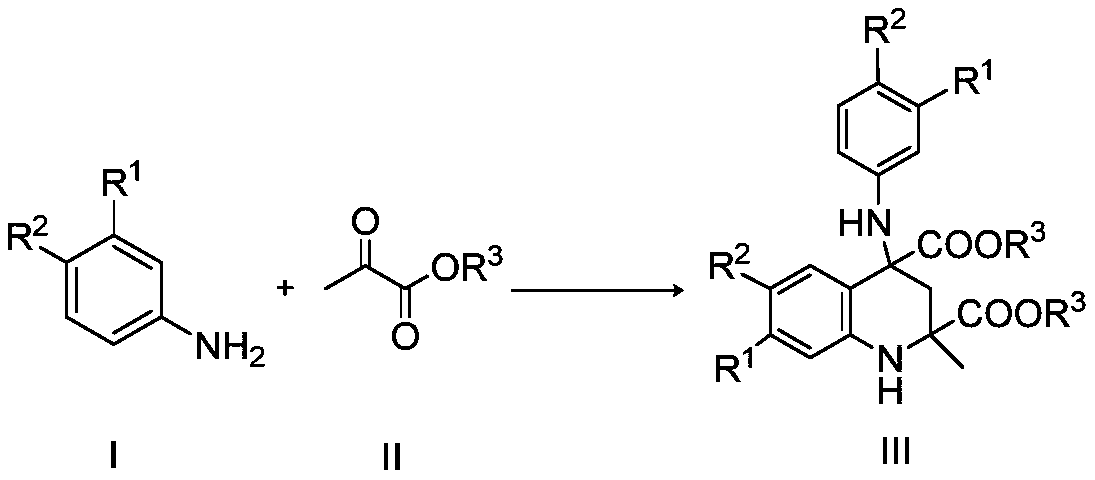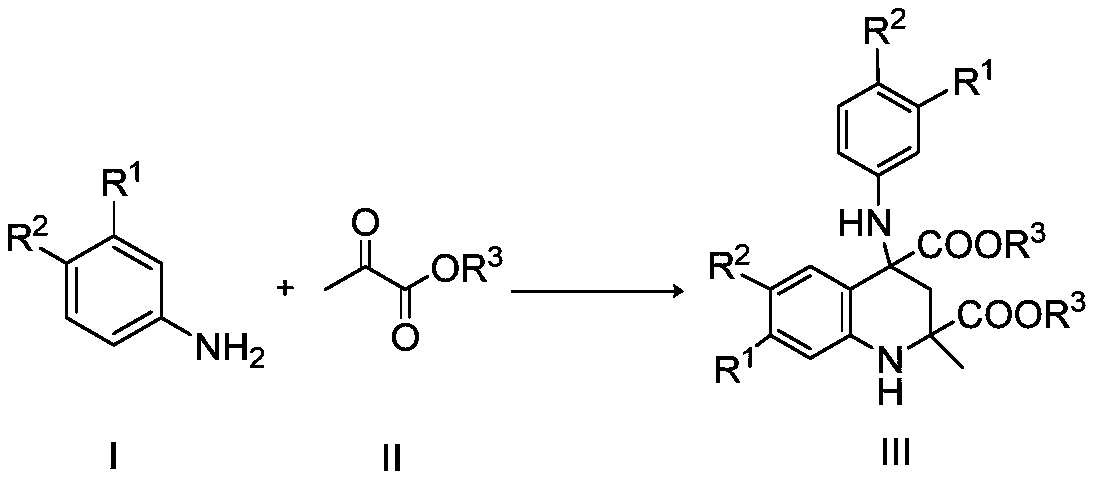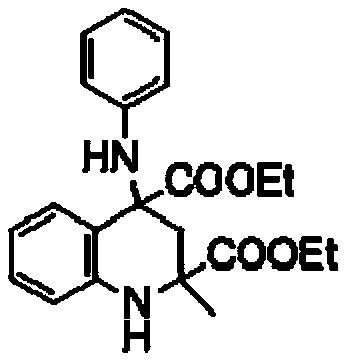Method for synthesizing tetrahydroquinoline compounds from arylamine and alpha-ketoester under catalysis of titanocene/Bronsted acid
A special acid-catalyzed arylamine and Bronsted acid technology is applied in the synthesis of tetrahydroquinoline compounds to achieve mild reaction conditions, high atom economy, and avoid the use of toxic reagents.
- Summary
- Abstract
- Description
- Claims
- Application Information
AI Technical Summary
Problems solved by technology
Method used
Image
Examples
Embodiment 1
[0018] Synthesize 2-methyl-4-(phenylamino)-1,2,3,4-tetrahydroquinoline diethyl-2,4-dicarboxylate with the following structural formula
[0019]
[0020] Add 12.45mg (0.05mmol) titanocene dichloride and 12.07mg (0.05mmol) 3,5,6-trichlorosalicylic acid, 250μL absolute ethanol, 1750μL ultra Pure water, 132 μL (1.2 mmol) of ethyl pyruvate and 91 μL (1 mmol) of aniline were mixed uniformly and stirred at 40°C for 6 hours. The completion of the reaction was detected by TLC, and then 5 mL of 0.5 mol / L sodium bicarbonate aqueous solution was added to the reaction mixture, the organic phase was extracted with dichloromethane (3×15 mL), dried over anhydrous sodium sulfate and concentrated in vacuo to give the crude product Purified by silica gel (petroleum ether / ethyl acetate) column chromatography to obtain 2-methyl-4-(phenylamino)-1,2,3,4-tetrahydroquinoline diethyl-2,4-di The yield of carboxylic acid ester is 93%, and the structural characterization data are: 1 H NMR(600MHz, CDCl 3 )δ7...
Embodiment 2
[0022] Synthesize 2,7-dimethyl-4-(p-tolylamino)-1,2,3,4-tetrahydroquinoline-2,4-dicarboxylate with the following structural formula
[0023]
[0024] In this example, the aniline in Example 1 was replaced with equimolar 4-methylaniline, and the other steps were the same as in Example 1, to obtain solid 2,7-dimethyl-4-(p-tolylamino)-1, The yield of 2,3,4-tetrahydroquinoline-2,4-dicarboxylate is 90%, and the structural characterization data are: 1 H NMR(600MHz, CDCl 3 )δ7.04(s,1H), 6.89-6.79(m,3H), 6.52(d,J=7.3Hz,1H), 6.25(d,J=7.0Hz,2H), 4.34(s,1H), 4.20(s,1H),4.08(s,1H),3.78(s,2H),3.31(s,1H),3.17(s,1H), 2.59(d,J=13.5Hz,1H),2.11(d ,J=17.5Hz,6H),1.38(s,3H),1.12(d,J=5.3Hz,3H),0.60(s,3H); 13 C NMR(151MHz, CDCl 3 )δ176.12,173.02,142.71,141.51,130.73,129.62,129.20,127.54,127.19,126.82,119.70,115.76,115.22,114.36,61.68,61.28,60.35,55.17,36.42,27.97,20.59,20.41,14.11,13.11
Embodiment 3
[0026] Synthesize 6-(tert-butyl)-4-((4-(tert-butyl)phenyl)amino)-2-methyl-diethyl-1,2,3,4-tetrahydroquinoline with the following structural formula -2,4-Dicarboxylate
[0027]
[0028] In this example, the aniline in Example 1 was replaced with equimolar p-tert-butylaniline, and the other steps were the same as in Example 1, to obtain a solid 6-(tert-butyl)-4-((4-(tert-butyl) Phenyl)amino)-2-methyl-diethyl-1,2,3,4-tetrahydroquinoline-2,4-dicarboxylate, the yield is 85%, and the structural characterization data are: 1 H NMR(600MHz, CDCl 3 )δ7.17-7.15(m,1H), 7.09(dd,J=8.5,2.3Hz,1H), 7.04(d,J=8.6Hz,2H), 6.56(d,J=8.5Hz,1H), 6.30(d,J=8.6Hz,2H),4.21-4.10(m,2H),3.87-3.74(m,2H),3.34-3.26(m,1H),3.19(d,J=14.0Hz,1H) ,2.57(d,J=14.0Hz,1H),1.39(s,3H),1.19(s,3H),1.17(s,9H),1.12(s,9H),0.55(t,J=7.1Hz, 3H); 13 C NMR(151MHz, CDCl 3 )δ176.30,173.28,142.43,141.20,141.02,140.69,127.12,126.03,125.41,123.69,118.90,115.30,114.95,114.59,61.61,61.35,60.68,55.11,36.54,34.06,33.85,31.58,31.55,31. ,28.15,1...
PUM
 Login to View More
Login to View More Abstract
Description
Claims
Application Information
 Login to View More
Login to View More - R&D
- Intellectual Property
- Life Sciences
- Materials
- Tech Scout
- Unparalleled Data Quality
- Higher Quality Content
- 60% Fewer Hallucinations
Browse by: Latest US Patents, China's latest patents, Technical Efficacy Thesaurus, Application Domain, Technology Topic, Popular Technical Reports.
© 2025 PatSnap. All rights reserved.Legal|Privacy policy|Modern Slavery Act Transparency Statement|Sitemap|About US| Contact US: help@patsnap.com



